
Lankamala Wildlife Sanctuary in the Siddavatam forest range, once known for its rich biodiversity, has now gained prominence as a historical site following recent archaeological discoveries.
A research team led by Siddavatam forest range officer K. Kalavathi and Dr. K. Munirathnam Reddy, Director (Epigraphy) at the Archaeological Survey of India (ASI), Mysore, has uncovered ancient inscriptions and prehistoric rock art. Dating from the 4th to the 16th century CE, these findings suggest that Lankamala was a major Shaivite pilgrimage center frequented by North Indian devotees.
During a routine inspection in December 2024, Kalavathi identified rock inscriptions and carvings across Siddavatam, Madduru, Konduru, and Rolabodu forest areas. Following her report, Dr. Munirathnam obtained official permissions for a detailed study.
A team of experts from various states, including Bengaluru and Chennai, conducted an extensive survey from February 27 to March 1, focusing on Gopalaswami Konda at an altitude of 3,200 feet. They reportedly documented 12 label inscriptions in Siddhamatrika, Shankha script, and Devanagari.
Believed to date back to the 6th century CE, the inscriptions exhibit Kushan-era craftsmanship, created using a unique thumb-engraving technique.
Names like Vishishta Kankanadhadi, Yedharmaja, and Chandrahasa indicate that pilgrims traveled long distances to visit Lankamala’s temples. Researchers also identified an ancient pilgrimage route linking two Shaivite temples.
The ASI, supported by the Andhra Pradesh Forest Department, conducted an epigraphical survey across locations such as Nityapujakona, Akkādēvatala Konda, and Bandigani Chella near Rolla Bodu Base Camp. The team documented 15 inscriptions from the 4th to the 10th century CE, offering significant historical insights. Conducted at an altitude of 2,200 feet, the survey required navigation through steep terrain.
Additionally, researchers explored three rock shelters, one of which contained prehistoric paintings depicting animals, geometric patterns, and human figures. Created using red ochre, kaolin, animal fat, and crushed bones, these artworks date back to the Megalithic (Iron Age) and early historic periods (2500 BCE–2nd century CE).



